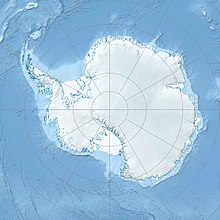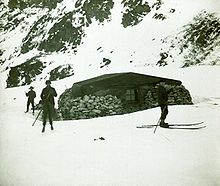Orcadas station
Coordinates: 60 ° 44 ′ 16.7 " S , 44 ° 44 ′ 16.4" W.
The Orcadas Station ( Spanish Base Orcadas ) is an Argentine research station in the Antarctic . It is located on the Ibarghur Isthmus of Laurie Island in the archipelago of the South Orkney Islands . They are 1501 km from the nearest port of Ushuaia on Tierra del Fuego ; the closest Antarctic station is the British Signy station , 51 km away.
history
At the beginning of the 20th century, the Scottish National Antarctic Expedition , led by William Speirs Bruce , set out to penetrate the Wedell Sea . When this venture failed, she devoted herself to exploring the South Orkney Islands. A stone hut built in 1903 on Laurie Island formed the basis for their exploratory trips. The hut was handed over to Argentine researchers in 1904, who have operated it since then under the name Orcadas. Until 1927 there was no Argentine station manager. These came from Scandinavia, England, Germany or Russia. The German station manager Otto Diebel (1858–1905) died here on September 25, 1905 .
The station has been continuously inhabited since February 22, 1904, making it the oldest continuously inhabited station in Antarctica. Orcadas is also the first permanent station mentioned in the Antarctic Treaty system and is now one of six Argentine Antarctic stations. The first radio station in the Antarctic was put into operation on Orcadas in 1927 .
Infrastructure
Orcadas lies at a height of four meters above sea level on a stony ground and is 170 meters from the coast. The station accommodates up to 45 people in a total of 11 buildings in summer and an average of 14 people in winter.
The total area of the station is 4800 m², the area in the buildings 2101 m², of which 423 m² are intended for the accommodation of the residents. The station consumes 192,000 liters of fuel per year, which is also used to generate electricity with four generators; the total water consumption is 1.08 million liters, whereby the water is obtained from the melting of ice and the wastewater is discharged into the sea. A doctor is on site, who has 20 m² of space with four beds available for patient care. Two ship deliveries per year are used to secure the supply of the station, and the station can also be reached by plane between November and March.
The main research areas on Orcadas are glaciology , seismology and meteorology .
Monument protection
The oldest buildings of the station, the "Omond House" from 1903, the Argentine magnetic observatory "Moneta House" built in 1905 and an Argentine meteorological hut, now stand next to a cemetery with twelve graves, the oldest of which dates from 1903 as HSM-42 historic site under the protection of the Antarctic Treaty .
Web links
- Orcadas station on the side of the Fundación Marambio (Spanish)
Individual evidence
- ↑ José Manuel Moneta: Four Antarctic Years in the South Orkney Islands: An Annotated Translation of Cuatro Años en las Orcadas Del Sur . Bernard Quaritch, London 2017, ISBN 978-0-9955192-0-6 .
- ↑ Reinhard Krause: Edmund Müller's report on his wintering on Laurie Island, South Orkney Islands, Antarctica, in the years 1926 and 1928 - a side light (PDF; 659 kB). In: Polarforschung 77, Heft 2–3, 2007 (published 2008), pp. 89–94.
- ^ HSM 42: Scotia Bay huts in the Antarctic Protected Areas Database on the Antarctic Treaty Secretariat website. Retrieved November 16, 2019 (English, Spanish, French, Russian).



